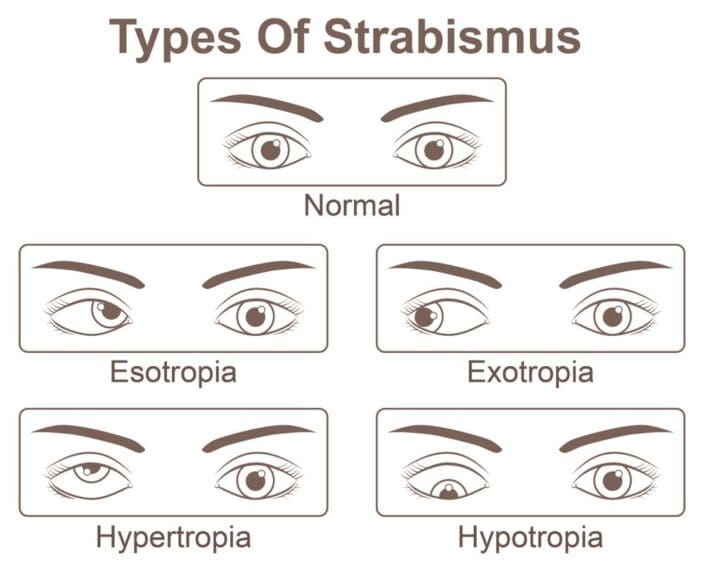Strabismus (Crossed Eyes): Treatment Options in 2022
Home / Eye Conditions & Eye Diseases /
Last Updated:
Vision depth and precision depend on two eyes focusing on the same thing at the same time. When one eye is not in partnership with the other, it’s known as strabismus.
Table of Contents
An eye doctor can diagnose strabismus as part of a routine eye exam. You will not need a special test or a specialist’s help to determine if this condition is impacting your eyesight.
If you have strabismus, your doctor can use special eyeglasses, eye patches, or surgery to correct the issue. Treatment is important, as this condition will not go away on its own.
What Is Strabismus?

Strabismus is a medical condition in which the eyes appear to be facing different directions. In plain language, it’s known as crossed eyes.
The human body has six muscles in the eyes that work together, directing both eyes into focusing on a single object. However, if you have strabismus, these muscles fail to work uniformly and result in one eye being focused on one thing and the other on something else.
You deserve clear vision. We can help.
With 135+ locations and over 2.5 million procedures performed, our board-certified eye surgeons deliver results you can trust.
Your journey to better vision starts here.
Strabismus describes a lack of muscle control (as opposed to muscle strength). The condition is usually inherited.
Classifications of Strabismus
Eye doctors classify strabismus by the direction in which the affected eye turns:
- If its inward turning, that is esotropia
- If it is outward turning, that is exotropia
- The upward turning affected eye is called hypertropia
- And the downward turning eye is referred to as hypotropia

Causes and Risk Factors
The causes and risk factors of strabismus differ by age. What causes the condition in children does not necessarily cause it in adults, and vice versa. So eye professionals take age into strong consideration when evaluating it.
Strabismus in Children
Some children are born with crossed eyes, called congenital strabismus, while others develop the condition before age 3. Regardless of when it occurs in infants or toddlers, the culprit is always considered genetic.
There exists few apparent causes of strabismus in children apart from inheritance. However, a tumor, an eye disorder or a problem in the nervous system that controls the eye muscles could cause a child to develop strabismus.
In addition, children with the following disorders can be at increased risk for contracting strabismus:
- Cerebral palsy
- Traumatic brain injury
- Noonan syndrome
- Congenital rubella
- Apert syndrome
Strabismus in Adults
In adults, strabismus often stems from a stroke. It can also occur from physical trauma or from childhood strabismus that went untreated or undertreated or in strabismus that recured or progressed.
Causes and risk factors of strabismus in adults include:
- Family history with strabismus
- Brain disorder or brain tumor
- Stroke
- Brain injury
- Farsightedness or vision loss
- Damaged retina
- Botulism
- Grave’s disease
Signs and Symptoms
For children with strabismus, common symptoms include:
- Eyes that don’t look at the same object at the same time
- Eyes not moving concurrently
- Squinting or closing one eye in bright sunlight
- Tilting or turning the head when looking at an object
- Complaints about blurred vision, tired eyes, double vision, or sensitivity to light
Symptoms for Adults include:
- Double vision (diplopia): Seeing two images of the same object when there should only be one.
- Visual confusion: Seeing two different images overlapping each other.
- Image jump: A displacement of an object caused by a lack of parallelism of the eyes while viewing a particular thing.
- Abnormal head posture: Caused by occasional turning of the face or tilting of the head when focusing on one object.
Strabismus Diagnosis

It is easier to diagnose strabismus in adults than in children because of the nature of tests required to make an accurate diagnosis. Most children with strabismus are diagnosed very young. An eye doctor can often tell when a child has developed crossed eyes by looking or performing a series of vision tests. In adults, a medical exam comes with a collection of precise medical history, current symptoms and any other health problems the patient is experiencing. The eye doctor can conduct comprehensive eye examination for a complete and accurate diagnosis of strabismus.
You deserve clear vision. We can help.
With 135+ locations and over 2.5 million procedures performed, our board-certified eye surgeons deliver results you can trust.
Your journey to better vision starts here.
How Strabismus Affects Vision
Because the various eye muscles work as a team, they intend to focus on the same object at the same time. If this does not happen, one of several vision problems develop:
- Lazy eye (amblyopia)
- Blurred vision
- Double vision
- Eyestrain
Lazy eye develops because of the misalignment of the eyes. Two images are produced simultaneously, and one eye (the healthy one) overworks in an attempt to create a single image. The other eye (unhealthy/strabismus-affected eye) becomes inactive, or lazy.
How Strabismus Is Treated
There are a variety of different approaches your doctor can use to help you overcome strabismus. The option that is right for you depends on your age, your overall health, and your personal preferences. Your doctor can help you make the right choice.
Your doctor might suggest:
- Glasses. Strabismus can worsen with strain, and if you’ve skipped correction for a vision issue, that can make your eyes work harder. A proper prescription could be a big help.
- Prism lenses. These specialized lenses for glasses bend the light as it enters your eye. Your muscles will not work so hard to move your eye, and that could ease your symptoms.
- Patches. Placing a patch over one eye could help to soothe overtaxed muscles and reinforce connections within your brain.
- Injections. A shot of botulinum toxin type A can weaken muscles that are working too hard, says the Cleveland Clinic. That injection could bring symmetry to eye muscles.
- Exercises. Muscles can be trained to work in harmony. Your doctor might ask you to move your eyes in a coordinated manner several times per day.

These treatments should help your eyes to work together, but your doctor will need to monitor your progress to make sure they are helping. You might have frequent visits to the office to talk with your doctor, and at each visit, your doctor might dilate your eyes and check your progress. It’s important to keep every appointment, so your doctor can monitor how well your eyes are responding.
If these steps do not work, surgery might. An eye surgeon can tighten up loose muscles that control the eye. That could help them pull in partnership with their companions, and your eye misalignment could fade.
The American Association for Pediatric Ophthalmology and Strabismus says there is no age limit for this surgery. Even people 90 and older can benefit from surgical treatment for this condition. In most cases, insurance will cover this surgery. It’s not a cosmetic condition. It’s an issue that will impact your ability to see, so this is considered a functional correction.
It might seem unusual to have surgery for something that seems simply bothersome. That might be especially true if you’ve lived with strabismus your whole life. But it’s important to remember that this is not just a cosmetic concern.
Your brain can make adjustments that cut off communication with one eye. You will lose depth perception, and that can limit your ability to do all sorts of things safely. Driving, cooking, knitting, and more could all become impossible for you.
If you are living with strabismus, talk with your doctor about what therapies are right for you.
Bilateral Strabismus Surgery
While most treatments for strabismus involve strengthening the muscles in the weaker eye so it focuses better, there are some instances in which someone with strabismus may need bilateral strabismus surgery.
This procedure adjusts the muscles that change the alignment of the eyes relative to each other, either loosening or tightening them. While you may undergo a procedure on just one eye, or unilaterally, many surgeons find better outcomes if both eyes are adjusted (bilaterally).
The surgery adjusts the eye muscles attached to the sclera, or the wall of the eye, which are covered by the conjunctiva, a thin layer of transparent tissue that protects the outermost parts of the eye. After using local anesthetic eye drops, the surgeon will create a small incision in the conjunctiva and adjust the scleral muscles either by:
- Detaching the muscle and moving it further back, so it is looser.
- Detaching the muscle, removing a portion, and then suturing it back in place, making a more tense muscle.
You will need a few weeks to recover from the procedure and achieve good vision. You may need to take antibiotics and steroids to stave off infection. You’ll also need to maintain consistent visits with your ophthalmologist to monitor healing, lower rates of activity to promote healing, and temporarily use an eye patch to protect the eye.
Immediate, common side effects after bilateral strabismus surgery include:
- Pain in and around the eyes.
- Reddish tint to the whites of the eyes.
- Itching or dry eye.
- Double vision.
- Blurry vision.
Typically, you should not drive for at least one week after the procedure, so make sure someone is available to help you get to and from any eye exams. Typically, you can perform simple relaxing activities like reading and watching TV about a day or two after the operation, and you can return to work or school after about a week.
You should avoid moderate or high-intensity activities like forceful exercise for between two and four weeks or until your ophthalmologist clears you to try them. Avoid makeup and contact lenses for about a month. If your child undergoes bilateral strabismus surgery, do not let them play with anything they can get in their eyes, like sand or paints.
There is no age limit for this procedure, so even an older adult who has long struggled with strabismus may benefit from this operation. If you are an adult, you may need more than one surgical treatment, along with eye exercises and training, to fully treat strabismus.
Since strabismus is a medical condition, your vision insurance will cover at least part of the procedure. Your optometrist or ophthalmologist can let you know if you or your child is a good candidate for this procedure.
While surgery is considered a last resort, bilateral strabismus surgery can benefit you by improving or restoring your depth perception, clear and single-focused vision, and much more.
Prevention
There is no sure way to prevent strabismus because you can’t control the situations from which the condition develops. Your genetics are your DNA, which you inherit from your parents.
You have more control about not developing strabismus as an adult simply because you can follow all the medical advice and precautions about one major event that causes it – a stroke. But you can’t control whether you will experience brain trauma or other things.
You can prevent complications that accompany it, such as those that affect the vision listed above, through early detection.
Screen children for vision health before they attain six months of age and continually between age 3 and 5, particularly if the family has a history of strabismus.
You deserve clear vision. We can help.
With 135+ locations and over 2.5 million procedures performed, our board-certified eye surgeons deliver results you can trust.
Your journey to better vision starts here.
References
- What Is Strabismus? (April 2014). American Academy of Ophthalmology.
- Strabismus. Prevent Blindness.
- Strabismus (Crossed Eyes). American Optometric Association.
- Strabismus. (March 2019). U.S. National Library of Medicine.
- What’s to Know About Squint, or Strabismus? (March 2017). Medical News Today.
- Strabismus (Crossed Eyes): Management and Treatment. (January 2019). Cleveland Clinic.
- Adult Strabismus. (November 2016). American Association for Pediatric Ophthalmology and Strabismus.
- Strabismus Surgery. (March 2019). American Association for Pediatric Ophthalmology and Strabismus (AAPOS).
- Surgery: Squint. (January 2020). National Health Service (NHS).
- Adult Strabismus Treatment. (May 2020). American Academy of Ophthalmology (AAO).
- Amblyopia. (October 2021). U.S. National Library of Medicine.
- How to Perform a Basic Cover Test in Ocular Misalignment or Strabismus. (April 2015). University of Iowa Carver College of Medicine.
- Strabismus (crossed eyes). (April 2015). American Optometric Association.
- Strabismus. (October 2021). U.S. National Library of Medicine.
- Strabismus (Crossed Eyes) Symptoms. (retrieved October 2021). Stanford Health Care.
- Crossed-Eyes (Strabismus). (retrieved October 2021). Stanford Children’s Health.
This content is for informational purposes only. It may have been reviewed by a licensed physician, but is not intended to serve as a substitute for professional medical advice. Always consult your healthcare provider with any health concerns. For more, read our Privacy Policy and Editorial Policy.
